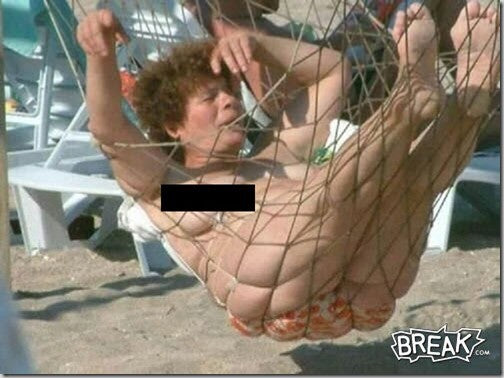[This blog post is part of Trek Light’s Sleeping In A Hammock series. If you came here first, do yourself a favor and check out what you’ve missed by starting at the beginning. Click the link above or right here!]
In Part I of this series, you learned to avoid the spreader bar if you want to have a balanced and healthy night sleep in your hammock (or if you just want to avoid getting tossed on the ground at any point in your day). In Part II we’re going to take a look at the next and even more important factor when it comes to getting the best hammock experience: the material, design and construction of the hammock. The material your hammock is made with and how it’s put together is crucial to your overall comfort and I’m here to again help you put an end to the hammock brainwashing and tell you what to look out for so you can avoid the dreaded ‘bad hammock experience’.
How To Tell If You’ve Been Hammock Brainwashed: A Test
1.) Yes or No: This looks comfortable and relaxing, the perfect place to lie down and take a nap:
and one more…
2.) Yes or No: This looks comfortable and relaxing, the perfect place to lie down and take a nap:
If I were into dramatics this is where I would say ‘BAM!’ and just end the blog post and walk out of the proverbial room and allow you to draw your own conclusions. But, I’m here to help and we should talk this through. I think it’s safe to guess that most of you answered ‘Yes’ to the first question and a slightly hesitant ‘No’ to the second. If you answered a strong ‘Yes’ to both of them I’m going to guess you’ve either got a rope fetish or you’ve got a severe case of hammock brainwashing. Only one of those I can help you with.
The top photo represents the iconic image of the hammock and it was just one of hundreds like it I came across while searching. It’s the type of image you see in posters, paintings and travel brochures and there’s a good reason for that – the hammock has long invoked feelings of vacation, freedom, travel and most importantly, comfort and relaxation.
What about the second image though? It’s just showing what the hammock above looks like up close, yet chances are that rope doesn’t scream comfort to you in the same way. The image of the rope hammock has dominated our culture to the point that it symbolizes comfort and relaxation for most people, but when you really look at it you’re staring at a bunch of criss-crossed ropes that have absolutely no reason for being synonymous with comfort and relaxation. That, my friends, is hammock brainwashing.
Prepare yourselves for what’s next.
The Human Waffle Effect (Why You Should Just Say No To The Rope Tattoo)
It’s typically warm outside when you’re in a hammock so more often than not there will be plenty of bare skin pressed up against the surface of your hammock. You climb in, find your sweet spot, get comfortable and fall asleep. Hammock bliss right? Let’s go over that again.
All of your weight. Pressing into a criss-crossing pattern of ropes widely spaced apart. Bare Skin. Gravity.
Normally I wouldn’t subject my readers to undue torture, but I think you’re going to need a visual on this:

(and with that the Trek Life blog will never be the same)
I call this phenomenon the Human Waffle Effect and the telltale marks it leaves behind are known as the (free) Rope Tattoo. Even if you’ve got every inch of skin covered up, it’s almost impossible to spend an extended period of time in a rope hammock without walking away with a Rope Tattoo. The Rope Tattoo isn’t just an uncomfortable souvenir, it likely means you were wreaking havoc on your circulation while you were sleeping and that alone defeats the entire purpose of spending time in a hammock. Have you ever fallen asleep on a wrinkled pillowcase (or face down on the grass if that example suits you) and woken up with Freddy Krueger-esque marks on your face? Now imagine what that lady’s body above is going to look like when she wakes up from a nap. It doesn’t take long to wind up a victim of the Human Waffle Effect and it’s clearly not comfortable or healthy. So why are rope hammocks still the most common hammock in our culture and why are we letting their image be used as the universal symbol of comfort and relaxation? Do the majority of Americans have a closet rope fetish we should know about?
What I believe it boils down to is a combination of our collective short attention span, an existing emotional/visual connection and a lack of awareness that other options even exist. Rope hammocks aren’t uncomfortable the moment you lie on them by any means. A well-made hammock that supports your body and gets you off the ground is going to feel great, but thanks to the ropes and gravity - the clock is ticking. What I’m seeing when I talk about hammocks with people from around the world is that our culture has been content to accept that the hammock experience ‘is what it is’. They believe the rope marks and the act of trying to avoid getting dumped on the ground are just all part of the experience and they choose to focus on that 15 minutes of bliss while ignoring the fact that it’s not really a sustainable activity.
It’s important to know that rope hammocks are just one way to make a hammock and there are plenty of better options out there for you, especially when you plan to sleep in your hammock. Besides the Human Waffle Effect, if your hammock has large openings in it like the rope hammocks pictured above, there are also plenty of places for you to get an arm or a leg caught in while you’re sleeping. If you want to spend any extended period of time in a hammock and walk away with a truly healthy and comfortable experience, you need to look beyond the classic rope design and find a soft, solid (or tightly woven) material.
Here are some points to remember:
- You’re never going to get a healthy, comfortable rest sleeping on something that looks like a fishing/cargo net. Gravity will work against you and your circulatory system. For a refresher, scroll back up and take a look at that image again.
- Your hammock should not be comfortable only in 15 minute spurts, it should be something you can spend hours in comfortably, sleep in overnight and it should never dig into your skin and leave marks - that’s not part of the hammock experience.
- Your hammock should be made with a smooth and comfortable material, which can be either a solid piece of material or a soft, tightly woven string design (like you see in most traditional hammocks made in Central/South America).

When buying a hammock there are lots of other factors to consider such as durability, strength, and breathability - which is a large part of the reason that Trek Light’s parachute nylon hammock design is as popular as it is.
The parachute nylon hammock material is both breathable and durable (as well as anti-rot/mildew, quick dry, ultralight and it holds up to 400lbs but you can read all about that here) and the silky smooth material is so comfortable on your skin it makes the rope hammock seem like an ancient torture device.
I did my best to focus this article more on what you should avoid rather than just telling you what makes a hammock like Trek Light’s rock as hard as it does – fortunately I just can’t say it any better than this picture:

Whichever style hammock you choose, I hope you’ve learned some more important details about what to look for and what to avoid when it comes to choosing a hammock. If you’ve experienced the Human Waffle Effect in the past or had a bad hammock experience because of poor construction or hammock materials, share your story with us in the comments. Or just let me know if you’re enjoying this series and learning anything new!
More to come in Part III ”The Hammock Angle: Make Mine A Double”
Part III is up! And it's got a longer, more explanatory title!
The Hammock Angle: How To Relax And Sleep Comfortably, Even If You're A Side Sleeper












Comments (25)
And to think…I was eating when I began to read this post. Needless to say, I’m not eating anymore.
Your point is well-made, my friend.
Us Hammock Brothers couldn’t agree more. We would never trade up our Trek Light Hammocks for any other hammocks especially Mesh ones!
Check out our link at and see for yourselves!
http://blog.hammockbrothers.com/2010/08/blog-post.html
Twitter Trackbacks…
…
I am considering a hammock for a small space. What is the minimum (and still comfortable) distance needed to set a one person hammock up?
@et50 – The answer to that question depends on a few factors so unfortunately there’s no definitive answer. For example, how tall you are is going to have an obvious effect on how much room you need to stretch out and get comfortable and if you’re only planning on hanging out for a bit you can usually get away with a shorter setup than if you’re looking to sleep in it night after night.
For sleeping comfortably I usually look for a minimum of 8’ from end to end (I’m 5’11"). I’ve hung it from shorter distances and comfortably hung out in the hammock plenty of times, but not generally for sleeping. Keep in mind you can lay at an angle across your hammock (much more so in the Double), so you can get some extra room to stretch out. And, with really short distances you can still always use the hammock as a chair/swing and just sit or lay perpendicular to the length of the hammock.
I think I’m hammock brainwashed. I am one of those who thinks of those rope hammocks as really comfortable. However, after reading your article, it actually got me thinking. Those rope tattoos get itchy afterwards and they’re really not good to look at. I will definitely be making that change to one of those comfortable hammock picture above, plus, I will be spreading the word to my friends and family.
[…] of the night (Trek Light Hammocks have a No-Flip™ design) and you don’t want to wake up with a permanent rope tattoo from sleeping on knots or string (silky smooth parachute nylon is where it’s […]
[…] you’ve gotten this far, it means you now know how to avoid the dreaded Human Waffle Effect and of course that the spreader bar just might be the devil that makes you spend more time trying […]
[…] Part II: The Human Waffle Effect […]
[…] […]